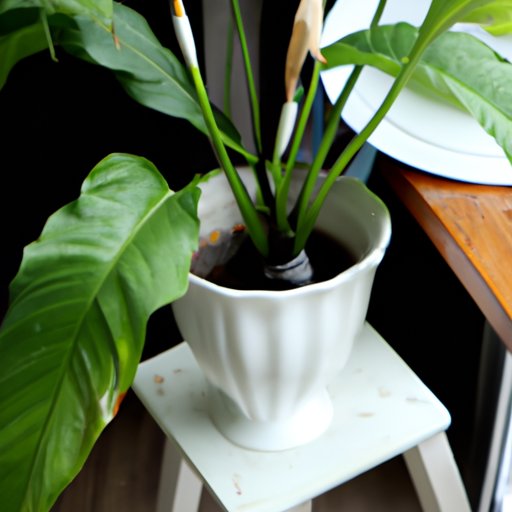
Introduction
Peace lilies are beautiful indoor plants that add personality and fresh oxygen to any room. These plants are known for their white spathe flowers and lush green leaves, which make them an excellent addition to any home or office. Originally from tropical regions of America, peace lilies are low maintenance plants that can survive in various conditions. However, to keep your peace lily healthy and thriving, you need to know the basics of taking care of it. In this article, we will outline the steps and tips needed to keep your peace lily thriving.
Watering
Watering is an essential part of taking care of your peace lily. Peace lilies require regular watering, but over-watering can be dangerous and lead to root rot. On the other hand, under-watering can cause dehydration and dryness that can eventually lead to wilting.
The ideal watering schedule for peace lilies is once a week, with occasional adjustments based on environmental conditions. To water your peace lily, gently pour water onto the soil until it starts to drain out from the pot’s bottom. Ensure that the pot has drainage holes to avoid the risk of waterlogging.
It is essential to check the soil moisture level regularly and recognize when it’s time to water. To test the soil’s moisture, insert a finger up to the second joint into the soil. If it feels dry, it’s time to water the plant. If the soil feels moist, keep checking until it’s dry enough.
Soil and Potting
The right pot size and type are essential for the health of your peace lily. The ideal pot size should be no more than two times the plant’s root ball’s size. Too large of a pot can retain more water, which can lead to overwatering. The pot should also have proper drainage holes to let excess water drain out.
The best soil for peace lilies is rich in organic matter, well-draining, and slightly acidic. You can create the perfect soil composition by mixing equal parts of peat moss, perlite, and vermiculite. It is essential to use light soil that doesn’t compress around the roots, which can cause the roots to suffocate.
Repotting is another vital part of taking care of your peace lily. Repotting can be done every two years or when the plant outgrows its current pot. Be careful to avoid damaging the roots while repotting.
Lighting
Lighting is a crucial factor for the growth of your peace lily. Peace lilies prefer bright, indirect light, but they can also tolerate low light. Direct sunlight can cause burns and damage the plant’s foliage.
It is best to place your peace lily near a window or in a well-lit room. You can also use artificial lighting sources such as fluorescent grow lights or LED lights to supplement natural light. It is essential to adjust the lighting placement depending on your home or office setup. Avoid placing the plant too close to an air conditioning vent or in direct sunlight.
Common Issues
Peace lilies, like any other plant, are not immune to problems. Common issues peace lilies face include yellowing leaves, brown tips, and browning of flowers.
Yellowing leaves may occur due to over or under-watering, low humidity, or direct sunlight. To address yellowing leaves, adjust the watering frequency and mist the leaves with water occasionally to increase humidity.
Brown tips may occur due to low humidity, over-fertilization, over-watering, and exposure to cold drafts. To address brown tips, increase humidity levels by placing a tray of water near the plant or using a humidifier. Reduce the watering frequency and avoid exposing the plant to cold drafts.
Browning of flowers may happen due to the age of the plant or incorrect temperature conditions. To address browning of flowers, remove wilted flowers and ensure that the temperature is within the recommended range.
Care Tips
Here are some extra tips for optimal care of your peace lily:
– Avoid temperature extremes – Peace lilies prefer temperatures between 65-80°F. Avoid exposing your peace lily to temperatures below 55°F or above 90°F.
– Keep plant away from kids or animals – Peace lilies are toxic to pets and humans if ingested. Ensure that the plant is out of reach of curious pets or young children.
– Strategies for keeping leaves clean and dust-free – You can wipe the leaves with a damp cloth or sponge occasionally or use a gentle spray of water to clean the leaves.
Conclusion
Taking care of a peace lily is easy and straightforward, as long as you follow the right steps. Water regularly, use the right pot size and type, provide proper lighting, and watch out for common problems. With the tips outlined in this article, you can keep your peace lily healthy, thriving, and add life to your home or office space.




